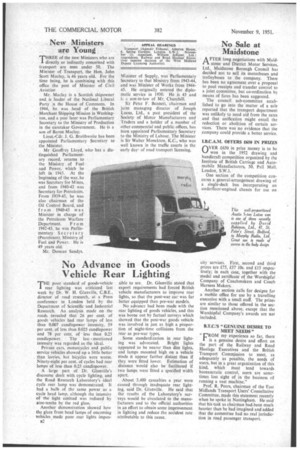No Advance in Goods Vehicle Rear Lighting
Page 36

If you've noticed an error in this article please click here to report it so we can fix it.
THE poor standard of goods-vehicle rear lighting was criticized last week by Dr. W. H. Glanville, C.B.E., director of road research, at a Press conference in London held by the Department of Scientific and Industrial Research. An analysis made on the roads revealed that 26 per cent, of goods vehicles had rear lamps of less than 0.007 candlepower intensity. 59 per cent, of less than 0.025 candlepower and 78 per cent, of less than 0.25
candlepower. The last mentioned intensity was regarded as the ideal.
Private cars, motorcycles and public service vehicles showed up a little better than lorries, but bicycles were worse. Ninety-eight per cent. of cycles had rear lamps of less than 0.25 candlepower.
A large part of Dr. Glanville's discourse dealt with cycle lighting, and the Road Research Laboratory's ideal cycle rear lamp was demonstrated. It had a bulb of the same power as a cycle head lamp, although the intensity of the light emitted was reduced by sine-tenths by the red glass.
Another demonstration showed how the glare from head lamps of oncoming vehicles made poor rear lightsimpos B2 sible to see. Dr. Glanville stated that export requirements had forced British vehicle manufacturers to improve rear lights, so that the post-war car was far better equipped than pre-war models.
No advance had been made with the rear lighting of goods vehicles, and this was borne out by factual surveys which showed that the post-war goods vehicle was involved in just as high a proportion of night-time collisions from the rear as pre-war types.
Some standardization in rear lighting was advocated. Bright lights appeared to be nearer than dim lights, and lamps mounted high on a vehicle made it appear farther distant than if they were fitted lower. Estimation of distance would also be facilitated if two lamps were fitted a specified width apart.
About 3.400 casualties a year were caused through inadequate rear lighting, said Dr. Glanville. He said that the results of the Laboratory's sur veys would be circulated to the manufacturers and to the official authorities in an effort to obtain some improvement ill lighting and reduce the accident rate attributable to this cause.




















































































